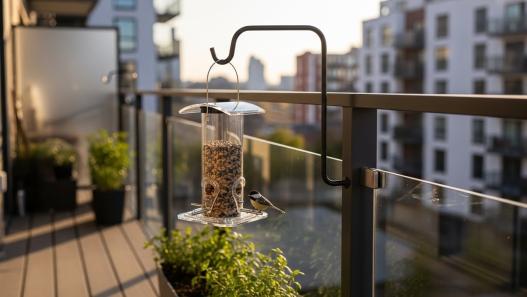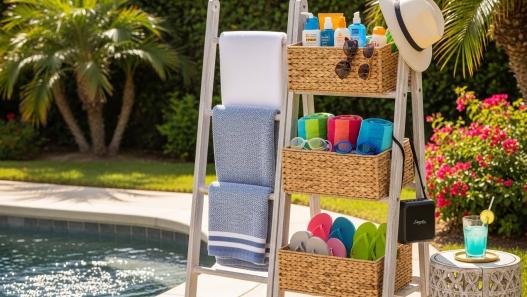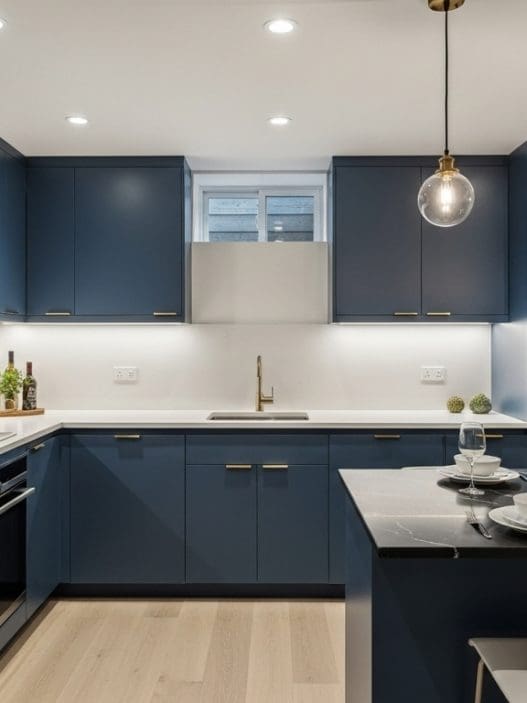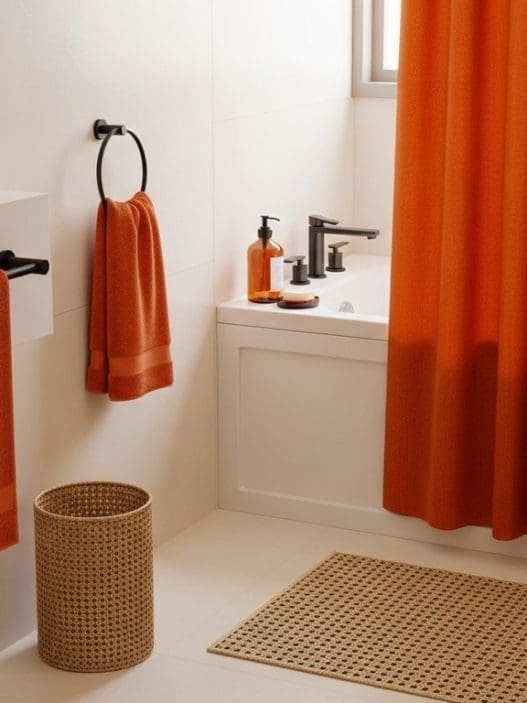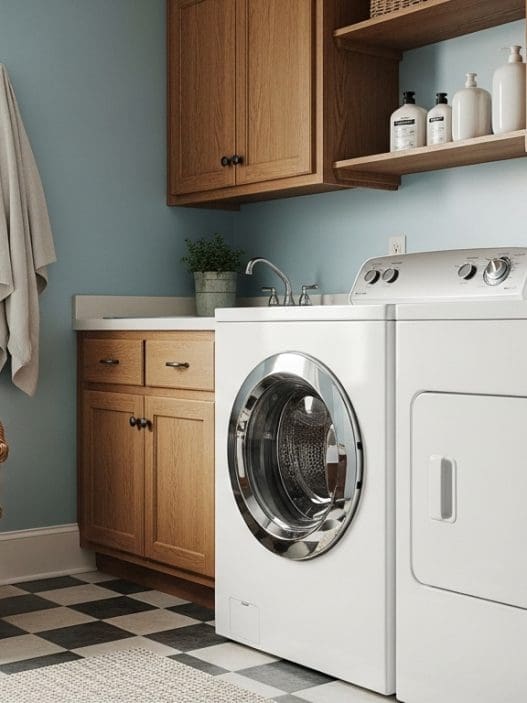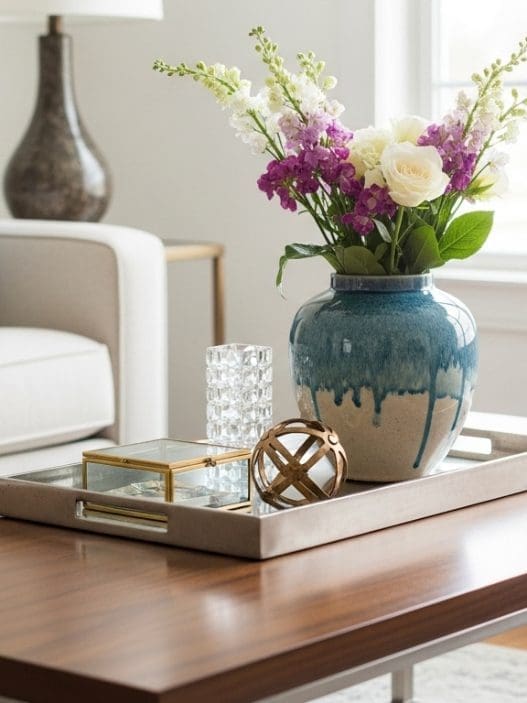Your front yard walkway is the first impression guests receive when approaching your home, and it plays a critical role in both function and design. Choosing the right entrance path is more than just a landscaping decision, it is a way to express your personal style while improving accessibility and safety. Whether you want to boost curb appeal or simply improve the flow of foot traffic to your doorway, the right front yard walkway idea can transform your entire entrance.
In this guide, we share 20 attractive front yard walkway ideas and designs that you can implement yourself. Each suggestion is grounded in aesthetics, durability, and ease of installation, with the goal of helping homeowners create a beautiful, welcoming path from the curb to the door. These ideas are suitable for all experience levels and focus on using common materials in creative ways.
1. Classic Brick Walkway
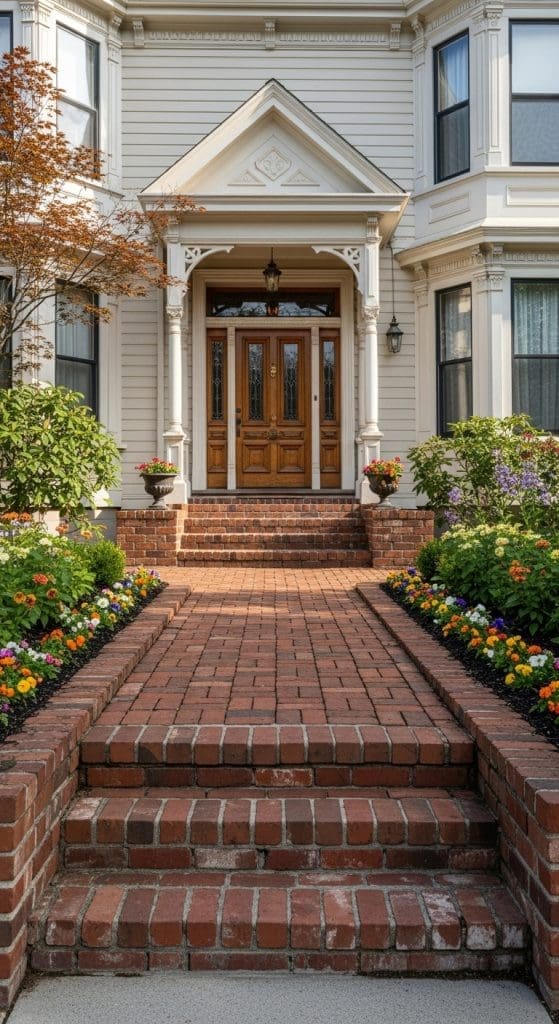
A brick walkway offers timeless charm and a solid surface that resists wear and tear. We recommend this for homeowners looking to enhance a traditional or colonial-style entrance. Bricks can be laid in various patterns like herringbone or basketweave, providing both traction and visual interest. The science behind this choice lies in the material’s density and weather resistance, making it ideal for climates with seasonal changes. Using reclaimed bricks can also reduce environmental impact while maintaining a rustic, historic look.
2. Stamped Concrete Path
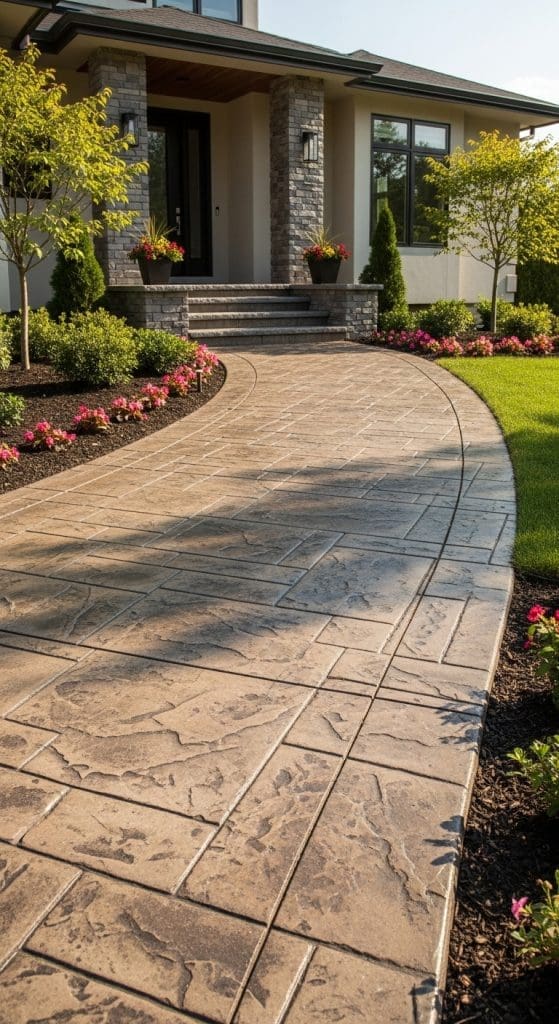
Stamped concrete mimics the look of natural stone or tile while offering the affordability and stability of poured concrete. We suggest this option if you want a custom design without sourcing expensive stone. The texture created during the stamping process improves traction and allows for color integration that complements your home’s exterior. Its ability to be poured in a single, continuous section reduces maintenance and helps prevent weeds from growing through the walkway.
3. Gravel with Stepping Stones
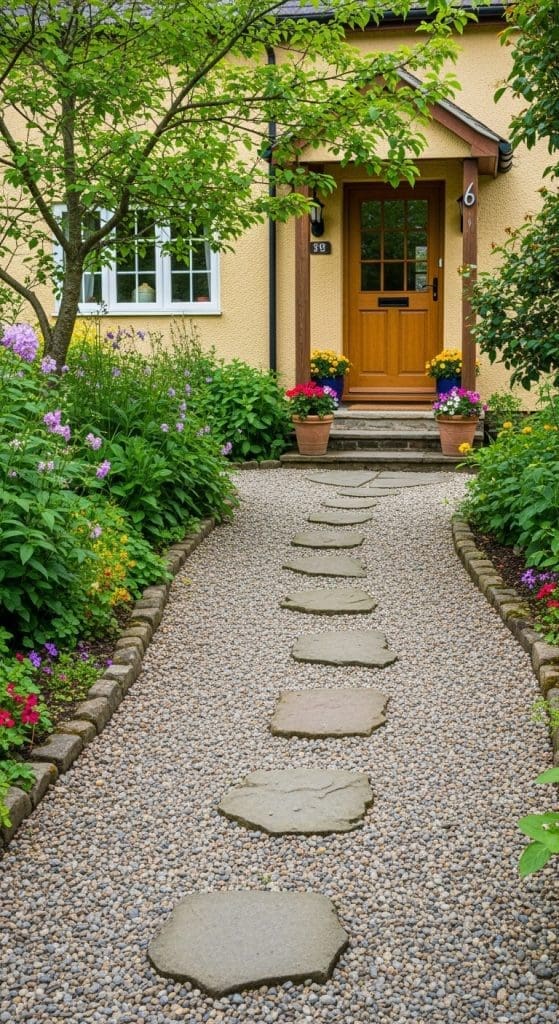
For a relaxed, cottage-style entrance, gravel paths with embedded stepping stones are highly effective. We use this approach to create a natural look that also manages water drainage efficiently. Gravel provides flexibility for curved designs and is cost-effective for large front yards. Pairing it with flat pavers improves stability where foot traffic is highest, preventing wear spots and keeping the surface clean.
4. Flagstone Walkway
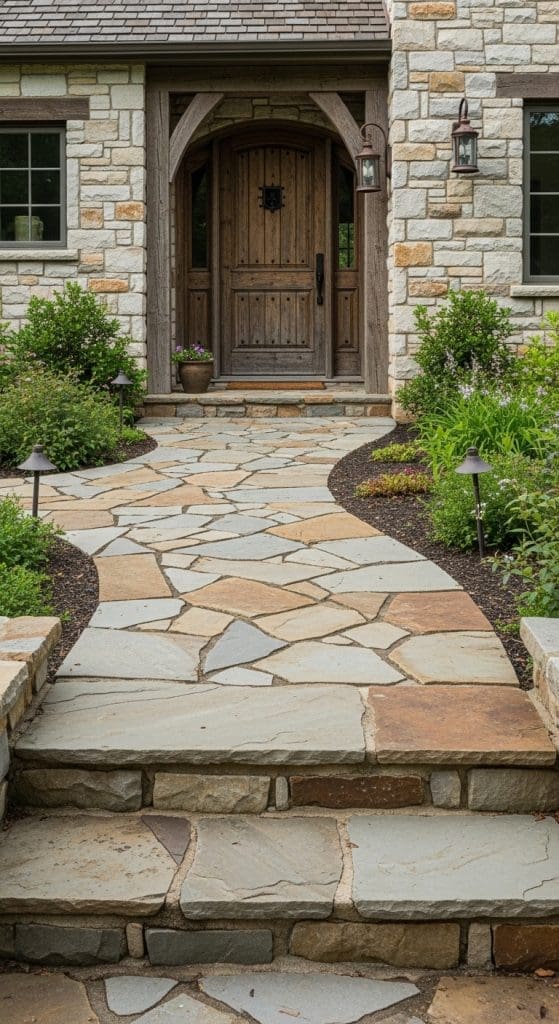
Flagstone is a durable and elegant natural stone that brings texture and color variation to your front yard walkway. We suggest this for modern or rustic home exteriors that benefit from organic shapes and tones. Each piece of flagstone is unique, and when laid with tight joints, it creates a stable surface resistant to slipping. The irregular edges offer visual softness, and the stone’s weight ensures long-term performance without shifting.
5. Paver Stone Path
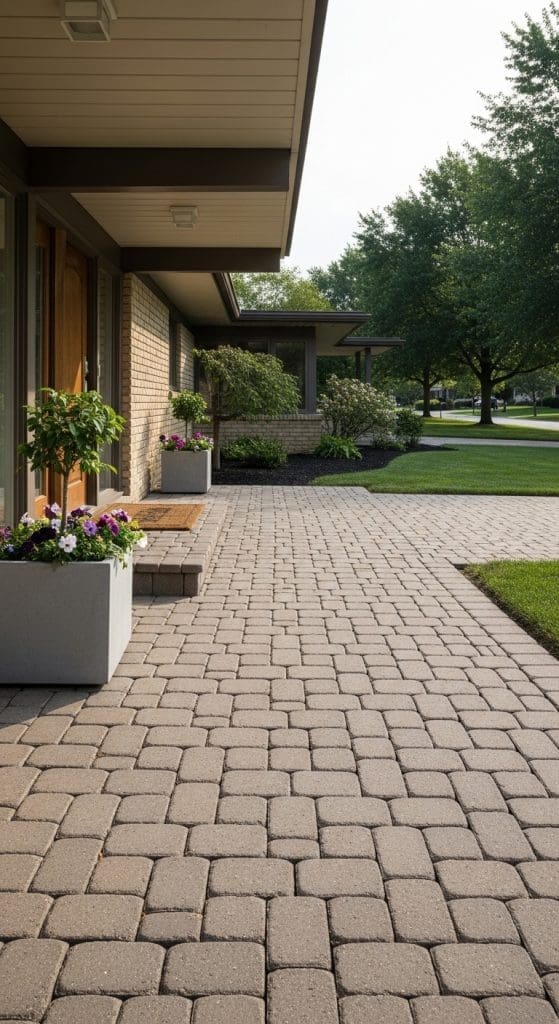
Interlocking pavers offer precise shapes and even spacing, which makes them ideal for geometric or symmetrical entrances. We recommend concrete or natural pavers for homeowners looking to balance beauty with ease of maintenance. Pavers allow for drainage through joints, minimizing puddles. They are easy to replace individually if damaged, making them a practical choice for high-use entrances.
6. Mulch and Timber Edged Path
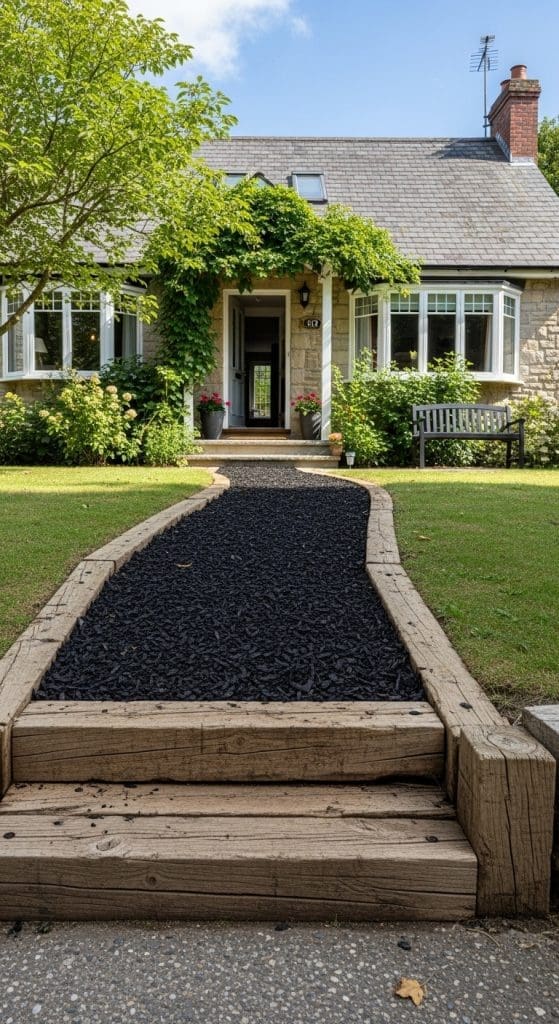
For natural or woodland-style gardens, a mulch path bordered by timber or landscape edging works well. We use this solution to keep costs low while maintaining a clean boundary for foot traffic. Mulch allows rain to pass through and supports healthy soil beneath, while wood borders prevent erosion and contain the walking area. This is best suited for low-traffic paths or informal entrances.
7. Modern Concrete Slab Steppers
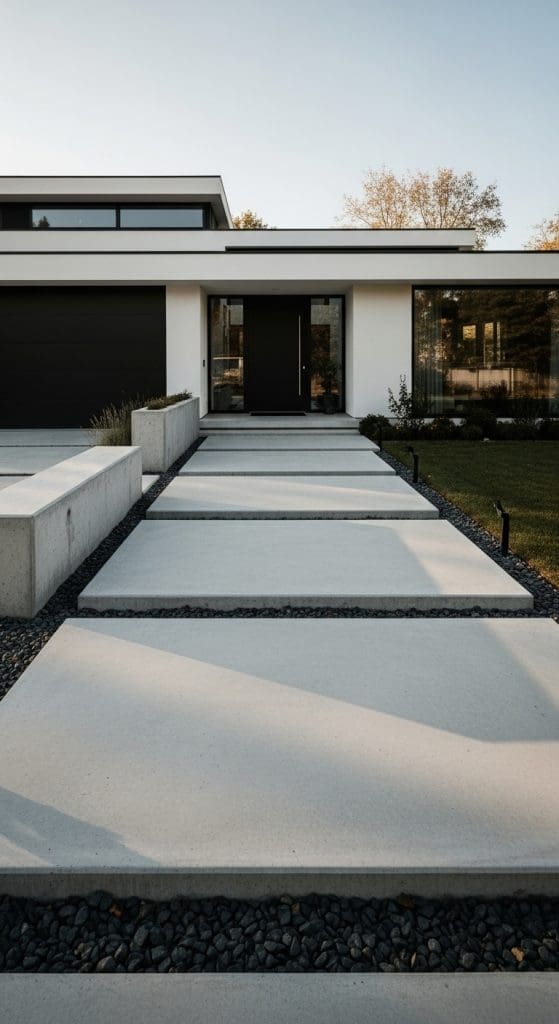
Oversized concrete slabs placed with spacing in between provide a contemporary, minimalist aesthetic. We suggest this for modern homes with clean lines and open landscapes. The science behind this walkway lies in its modular form, which can be customized in spacing and size to match surrounding architecture. Filling gaps with turf or gravel softens the look while aiding drainage.
8. Crushed Granite Walkway
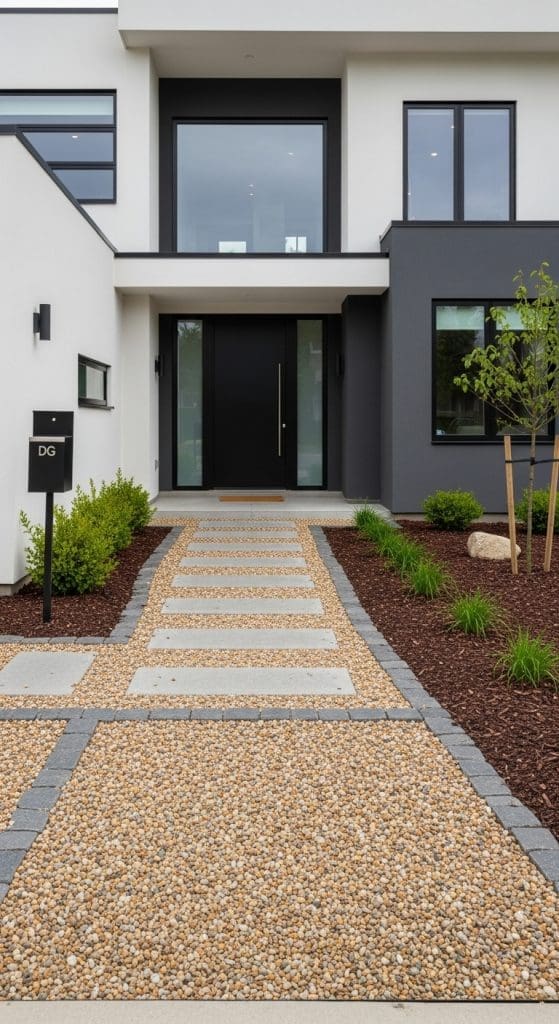
Decomposed granite (DG) is a fine gravel that compacts tightly, forming a durable and permeable walking surface. We recommend this for eco-conscious homeowners who want a natural texture without large stones. DG allows water to filter into the ground, preventing runoff and erosion. When installed with a stabilizer, it becomes firm enough for consistent foot traffic and wheelchair accessibility.
9. Curved Path with Flower Bed Borders
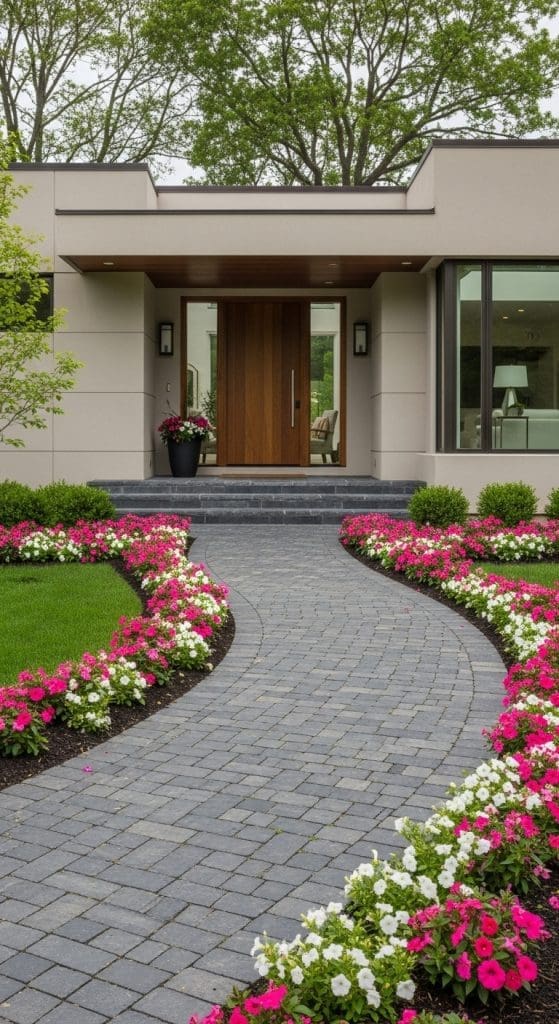
A curved front walkway softens the approach to your entrance and creates visual depth. We advise using curves to break up rigid landscaping or direct visitors naturally toward the front door. Lining the curve with flower beds or low hedges adds color and definition. The psychological effect of curves is inviting, drawing the eye inward and encouraging a slower, more welcoming pace.
10. Recycled Concrete Walkway
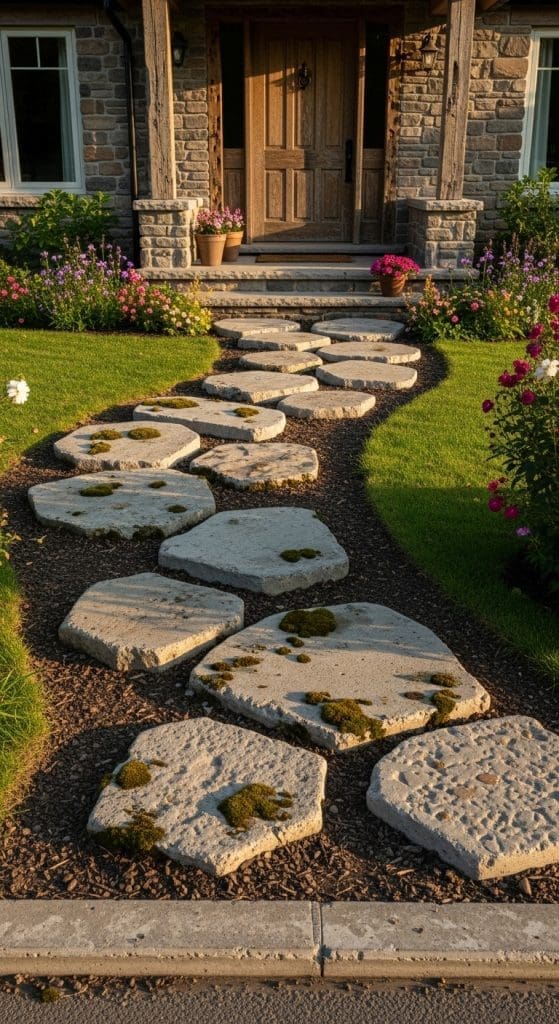
Repurposing concrete slabs or chunks into a mosaic-style path is a sustainable and budget-friendly idea. We recommend this for DIY homeowners who want to reduce waste while crafting a unique entrance. Crushed or broken concrete can be arranged like stepping stones, often with gravel or mulch in between. This method uses available materials and reduces environmental impact without sacrificing strength.
11. Herringbone Pattern Brick Path
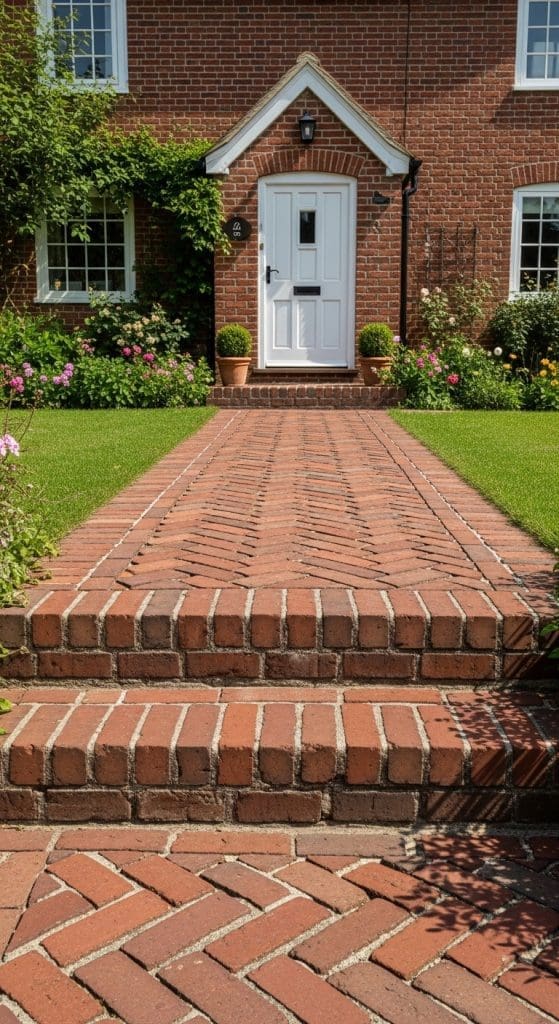
A variation of the classic brick walkway, the herringbone pattern adds complexity and increased stability. We use this approach in high-traffic entrances where shifting could be an issue. The interlocking pattern disperses weight evenly, reducing wear and resisting movement over time. It also adds texture and visual rhythm, making it ideal for narrow or long paths.
12. Slate Tile Walkway
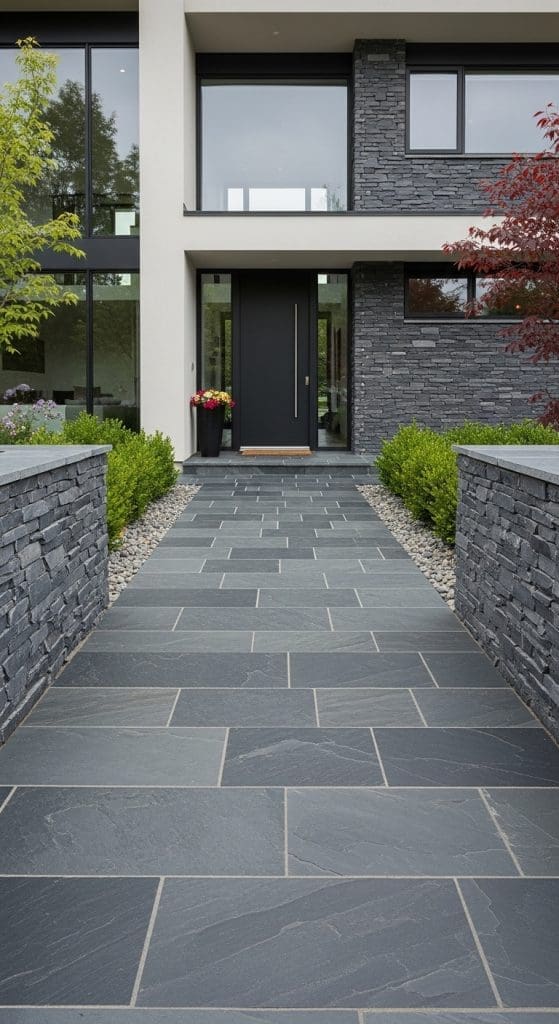
Slate tiles offer a sleek, durable surface that holds up well against moisture and foot traffic. We suggest this material for homeowners looking for a polished yet natural appearance. Slate’s layered texture provides grip in wet conditions, and its cool tones complement both contemporary and traditional homes. It requires proper sub-base installation to avoid cracking but performs well with regular maintenance.
13. Mosaic Pebble Path
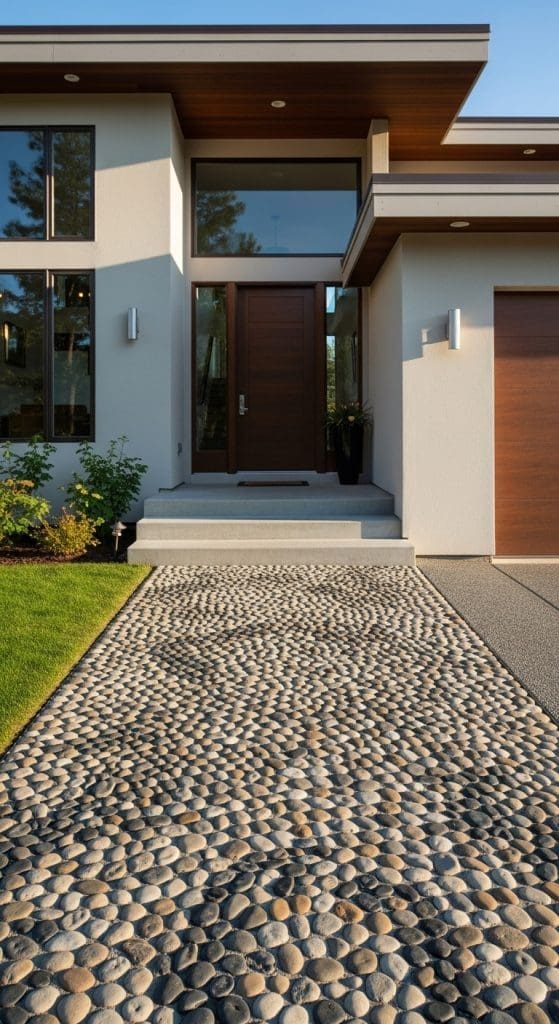
Creating a mosaic design with polished river stones or pebbles gives your front entrance a handcrafted, artistic flair. We recommend embedding pebbles into mortar or concrete for a flat, walkable surface. This idea combines aesthetics with durability and can reflect cultural or personal design motifs. The slight texture also adds non-slip properties, especially in rainy climates.
14. Grass Between Stone Steppers
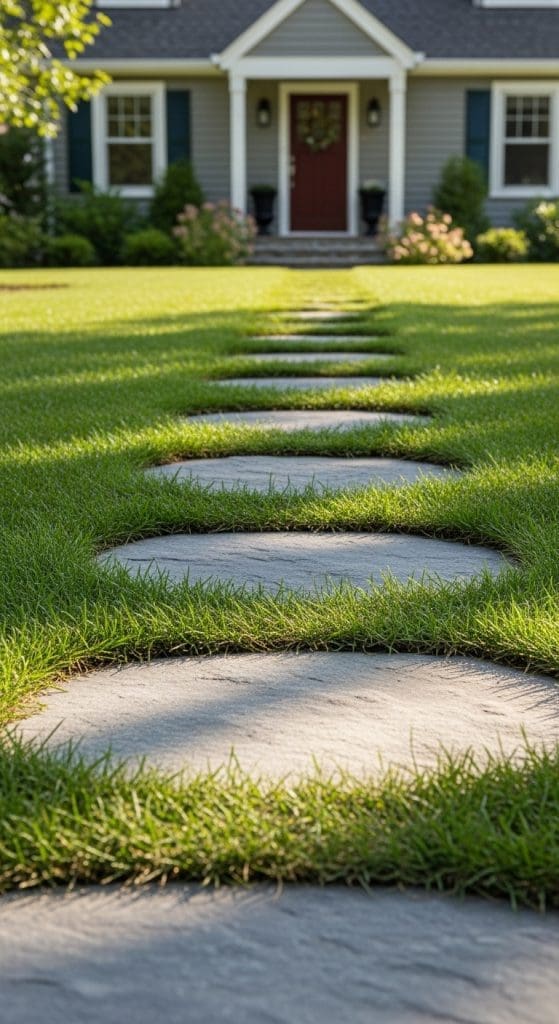
Placing flat stones over turf creates a walkway that blends naturally into your front lawn. We use this method for seamless transitions where the goal is to maintain a green, open landscape. Stones provide a stable walking surface while the grass keeps the look soft and organic. Regular trimming is required, but the result is charming and understated.
15. Concrete Pavers with Lighting
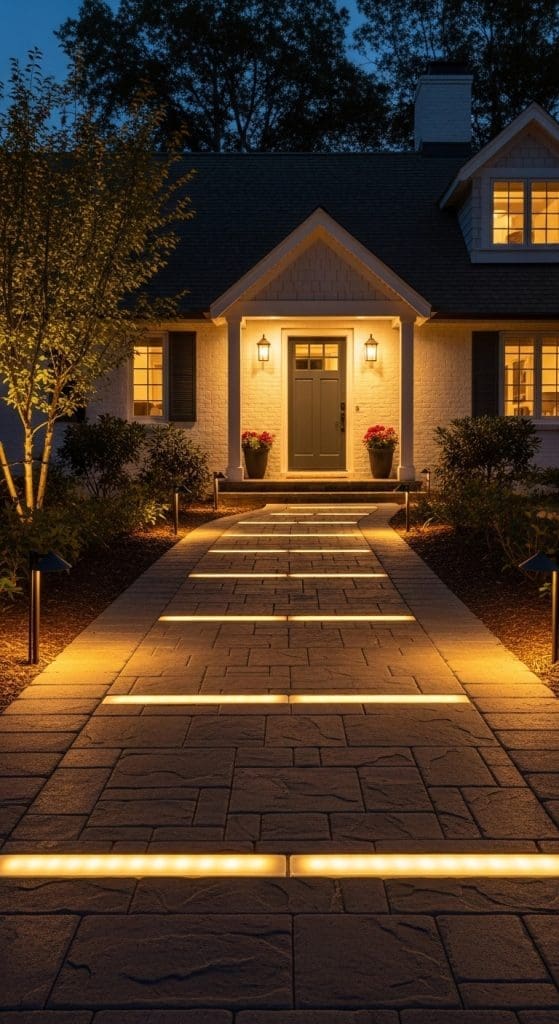
Incorporating low-voltage lighting into concrete paver walkways improves nighttime safety and adds aesthetic appeal. We recommend path lights or embedded LED pavers for well-lit entrances. Lighting highlights the walkway’s shape, ensures safe passage, and boosts curb appeal after dark. Timed or solar-powered options reduce energy use and simplify installation.
16. Wood Plank Walkway
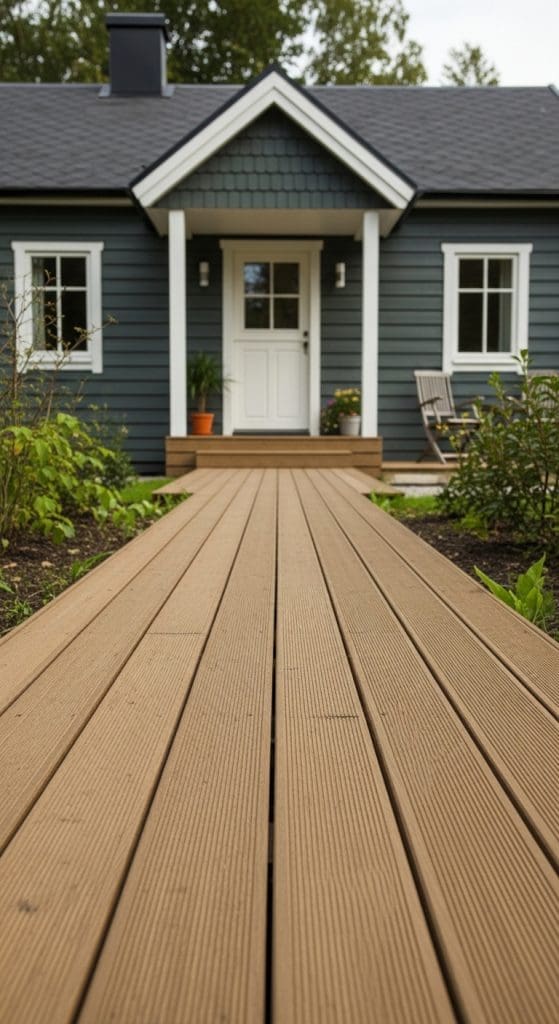
Pressure-treated or composite wood planks arranged side-by-side create a deck-like walkway. We use this in areas with uneven terrain or near porches to connect outdoor elements smoothly. Wood offers warmth and can be stained to match your home’s trim or shutters. It requires sealing against moisture but is ideal for elevated paths or boardwalk-style entrances.
17. Stone and Brick Combo Path
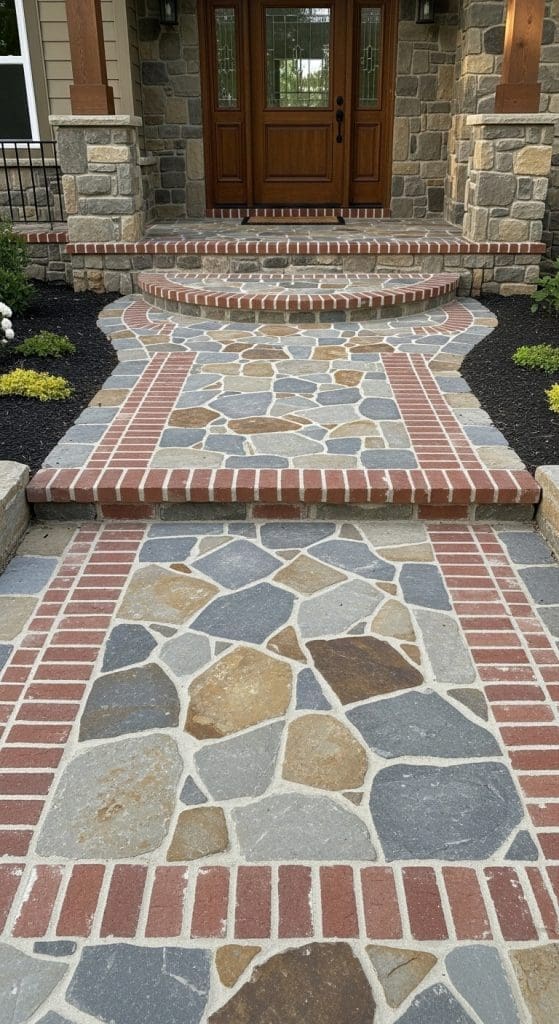
Combining natural stone with brick edging or inlays adds visual interest and strength. We recommend this technique to blend rustic textures with formal structure. The mix of materials draws attention to the walkway while providing functional advantages like edge definition and surface stability. It’s a great option when you want a custom look that uses leftover materials.
18. Circular Entry Path
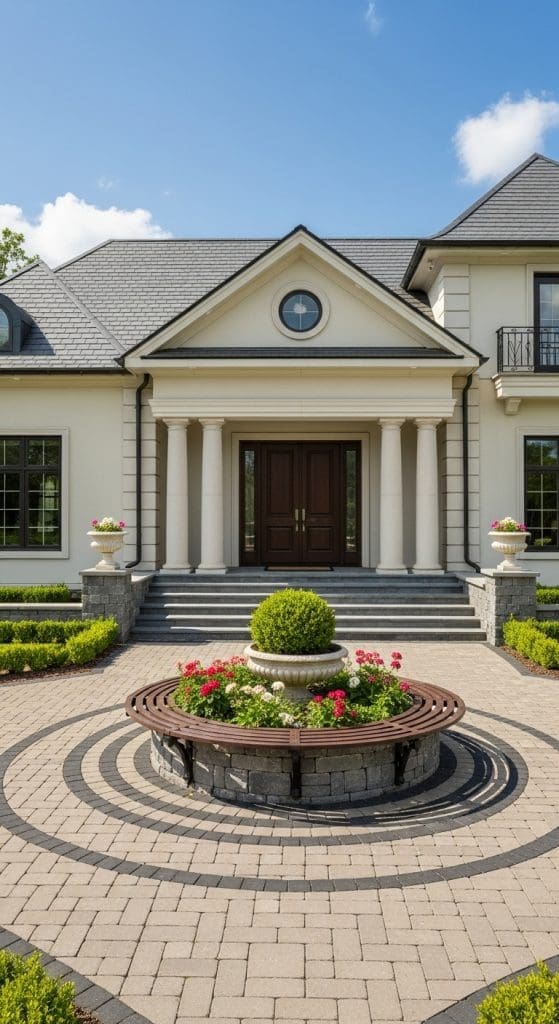
A circular or semi-circular layout invites visitors to approach the entrance from multiple angles. We use this design when space allows for a central focal point like a planter, fountain, or bench. The circular shape breaks the typical linear path and adds balance to wide or symmetrical homes. It also encourages a slower pace, ideal for large front yards.
19. Checkerboard Paver Layout
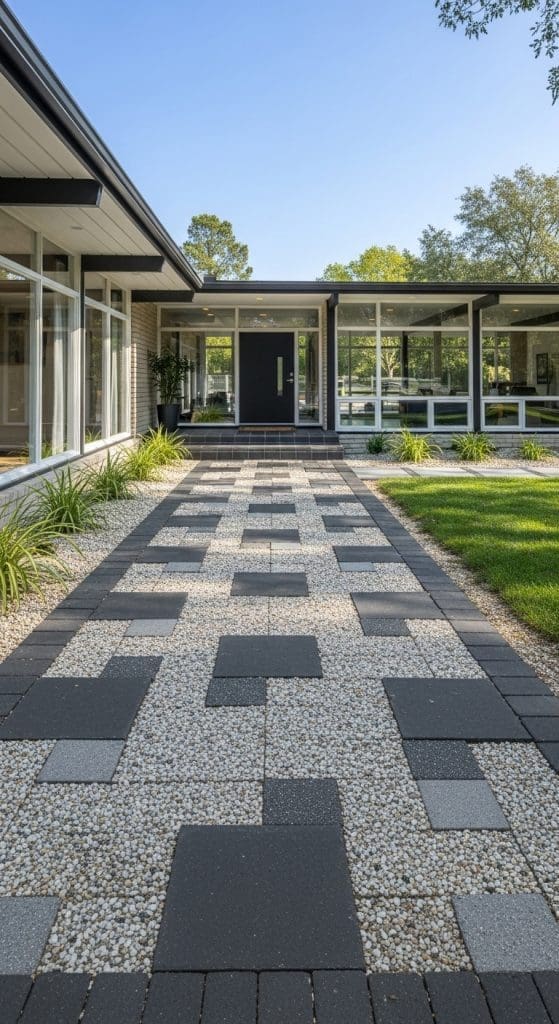
Alternating square pavers with grass or gravel creates a checkerboard pattern that is both fun and functional. We suggest this pattern for modern or mid-century homes looking to make a bold visual statement. The contrasting textures enhance curb appeal, while the spaced layout encourages natural water absorption. It’s best used in dry areas where turf maintenance is minimal.
20. Stepped Walkway for Slopes
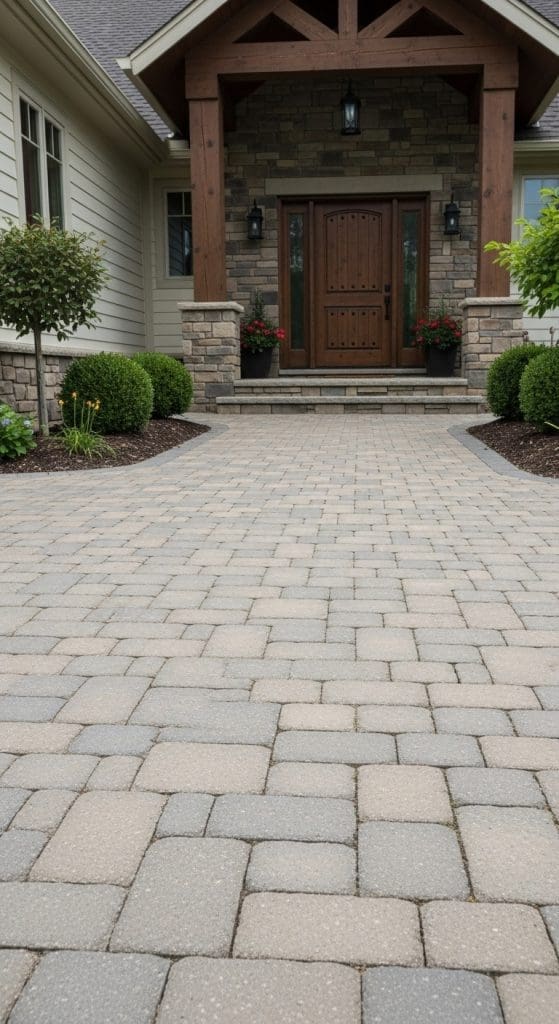
For sloped yards, a stepped walkway made from stone, timber, or concrete provides both safety and style. We recommend shallow risers and deep treads for comfort and accessibility. Steps break up steep elevation changes, allowing rainwater to run off safely and preventing soil erosion. Handrails or side planting can enhance stability and soften the structure visually.







